Strategic Analysis Report: Target Departmental Stores, Australia, 2018
VerifiedAdded on 2023/06/08
|16
|3449
|460
Report
AI Summary
This report delivers a comprehensive strategic analysis of Target, a departmental store operating in Australia under the ownership of Wesfarmers. The analysis commences with a concise overview of Target's background, encompassing its business scope, product offerings, and market presence. The report subsequently delves into an in-depth examination of Target's external environment, employing PESTLE and Porter's Five Forces analyses to assess the macro and micro environmental factors shaping its operations. Furthermore, the report conducts an internal analysis, utilizing SWOT and VRIO frameworks to evaluate Target's strengths, weaknesses, opportunities, and threats, as well as its resources and capabilities to ascertain its sustainable competitive advantages. The findings from the environmental assessments are then synthesized to identify key strategic issues, culminating in a set of actionable recommendations aimed at enhancing Target's performance and ensuring its long-term success in the competitive Australian retail market.
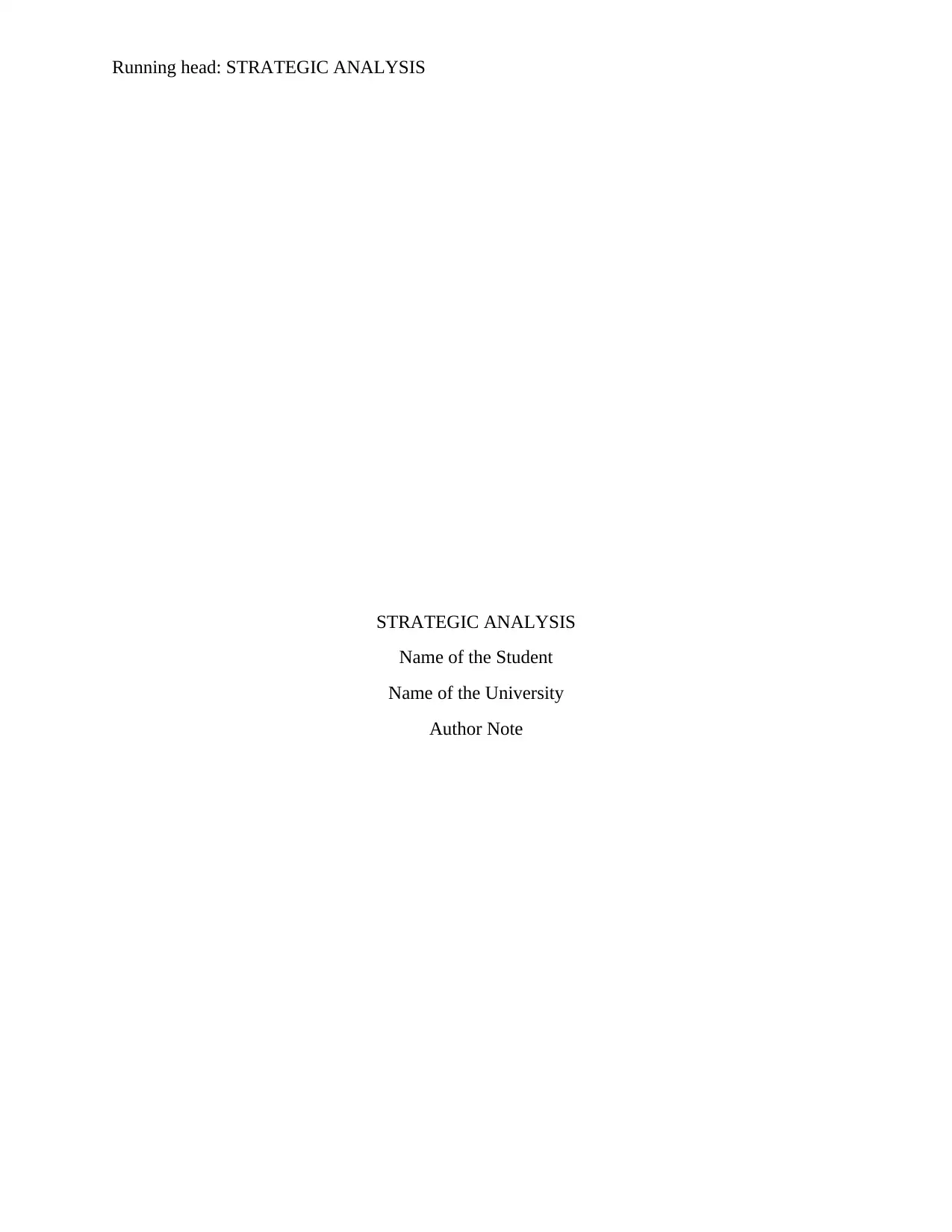
Running head: STRATEGIC ANALYSIS
STRATEGIC ANALYSIS
Name of the Student
Name of the University
Author Note
STRATEGIC ANALYSIS
Name of the Student
Name of the University
Author Note
Paraphrase This Document
Need a fresh take? Get an instant paraphrase of this document with our AI Paraphraser
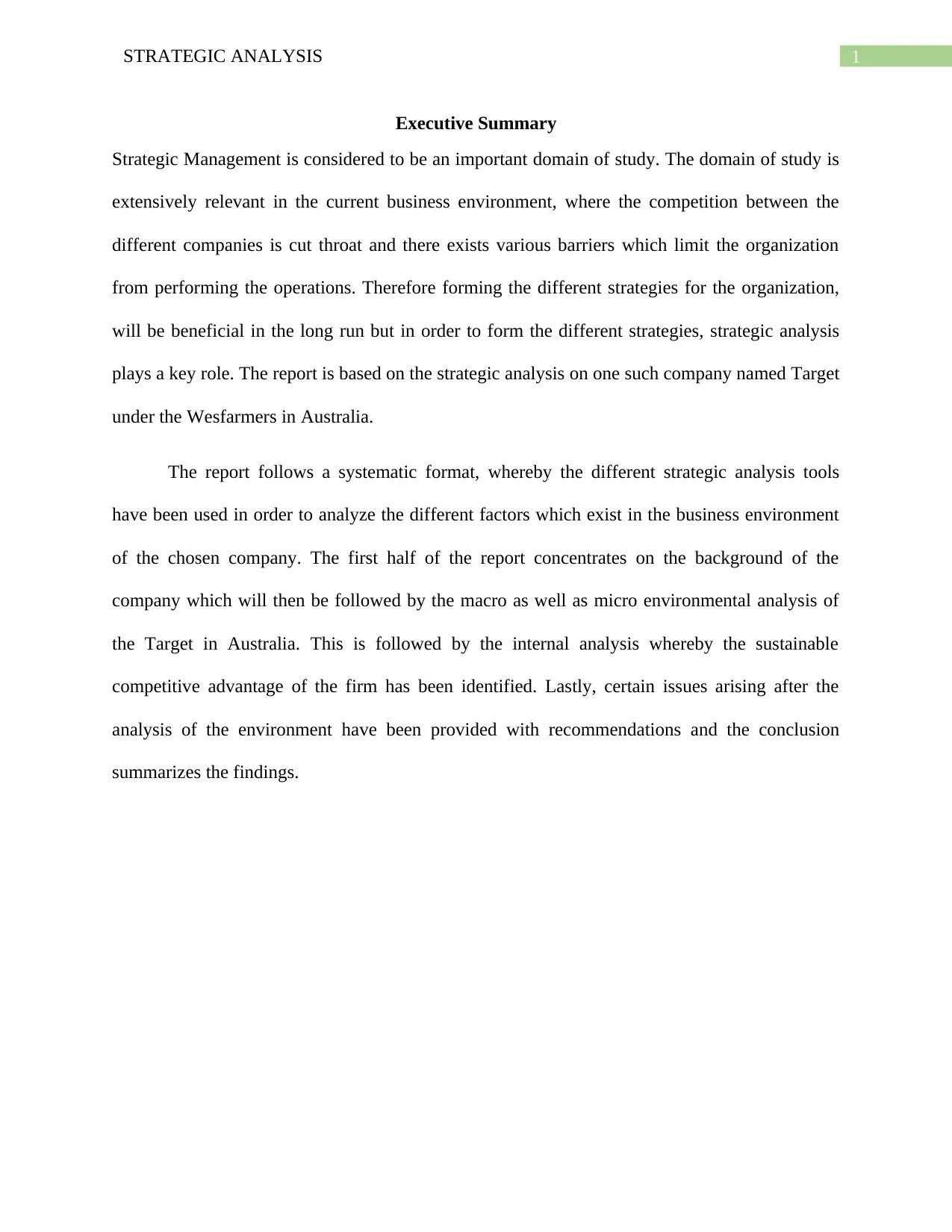
1STRATEGIC ANALYSIS
Executive Summary
Strategic Management is considered to be an important domain of study. The domain of study is
extensively relevant in the current business environment, where the competition between the
different companies is cut throat and there exists various barriers which limit the organization
from performing the operations. Therefore forming the different strategies for the organization,
will be beneficial in the long run but in order to form the different strategies, strategic analysis
plays a key role. The report is based on the strategic analysis on one such company named Target
under the Wesfarmers in Australia.
The report follows a systematic format, whereby the different strategic analysis tools
have been used in order to analyze the different factors which exist in the business environment
of the chosen company. The first half of the report concentrates on the background of the
company which will then be followed by the macro as well as micro environmental analysis of
the Target in Australia. This is followed by the internal analysis whereby the sustainable
competitive advantage of the firm has been identified. Lastly, certain issues arising after the
analysis of the environment have been provided with recommendations and the conclusion
summarizes the findings.
Executive Summary
Strategic Management is considered to be an important domain of study. The domain of study is
extensively relevant in the current business environment, where the competition between the
different companies is cut throat and there exists various barriers which limit the organization
from performing the operations. Therefore forming the different strategies for the organization,
will be beneficial in the long run but in order to form the different strategies, strategic analysis
plays a key role. The report is based on the strategic analysis on one such company named Target
under the Wesfarmers in Australia.
The report follows a systematic format, whereby the different strategic analysis tools
have been used in order to analyze the different factors which exist in the business environment
of the chosen company. The first half of the report concentrates on the background of the
company which will then be followed by the macro as well as micro environmental analysis of
the Target in Australia. This is followed by the internal analysis whereby the sustainable
competitive advantage of the firm has been identified. Lastly, certain issues arising after the
analysis of the environment have been provided with recommendations and the conclusion
summarizes the findings.
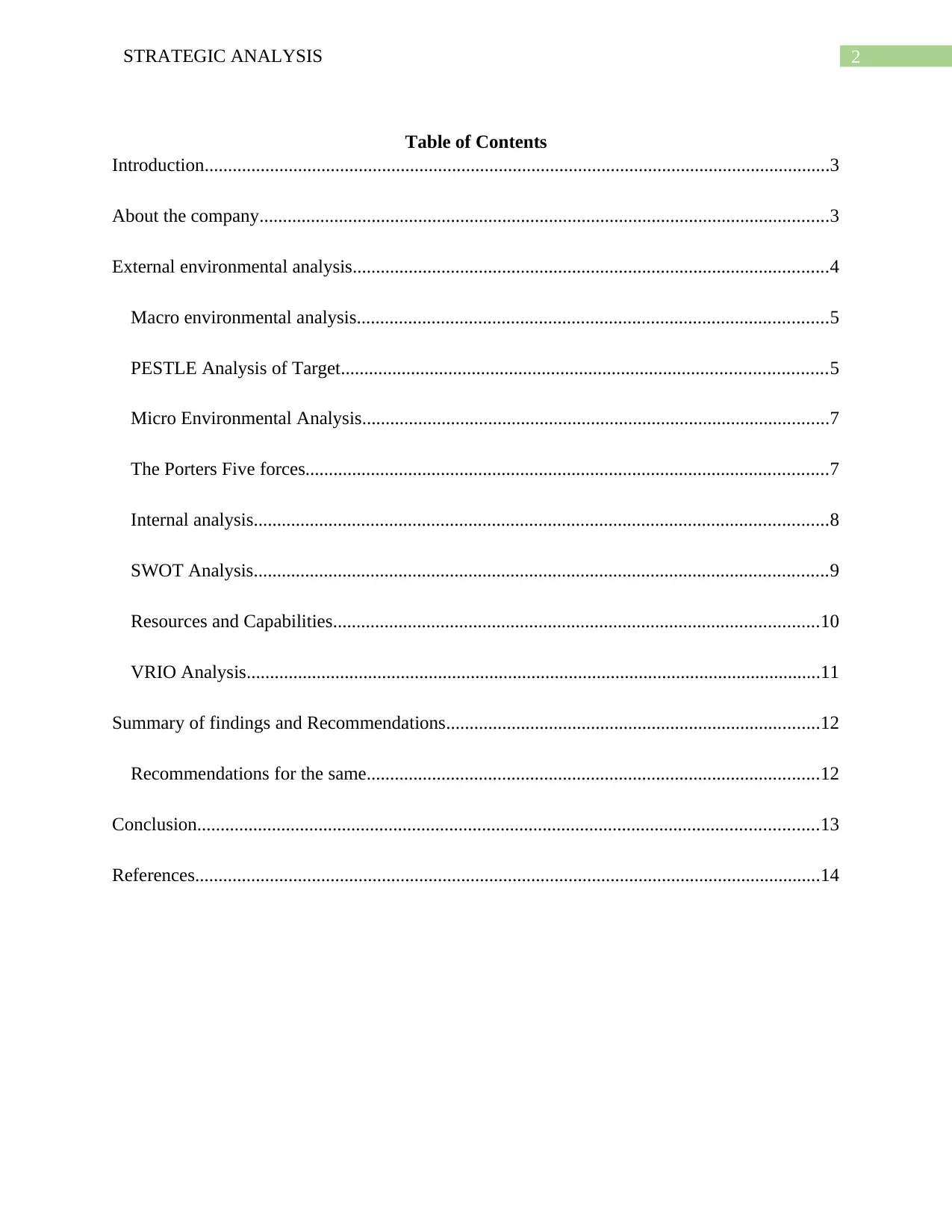
2STRATEGIC ANALYSIS
Table of Contents
Introduction......................................................................................................................................3
About the company..........................................................................................................................3
External environmental analysis......................................................................................................4
Macro environmental analysis.....................................................................................................5
PESTLE Analysis of Target........................................................................................................5
Micro Environmental Analysis....................................................................................................7
The Porters Five forces................................................................................................................7
Internal analysis...........................................................................................................................8
SWOT Analysis...........................................................................................................................9
Resources and Capabilities........................................................................................................10
VRIO Analysis...........................................................................................................................11
Summary of findings and Recommendations................................................................................12
Recommendations for the same.................................................................................................12
Conclusion.....................................................................................................................................13
References......................................................................................................................................14
Table of Contents
Introduction......................................................................................................................................3
About the company..........................................................................................................................3
External environmental analysis......................................................................................................4
Macro environmental analysis.....................................................................................................5
PESTLE Analysis of Target........................................................................................................5
Micro Environmental Analysis....................................................................................................7
The Porters Five forces................................................................................................................7
Internal analysis...........................................................................................................................8
SWOT Analysis...........................................................................................................................9
Resources and Capabilities........................................................................................................10
VRIO Analysis...........................................................................................................................11
Summary of findings and Recommendations................................................................................12
Recommendations for the same.................................................................................................12
Conclusion.....................................................................................................................................13
References......................................................................................................................................14
⊘ This is a preview!⊘
Do you want full access?
Subscribe today to unlock all pages.

Trusted by 1+ million students worldwide
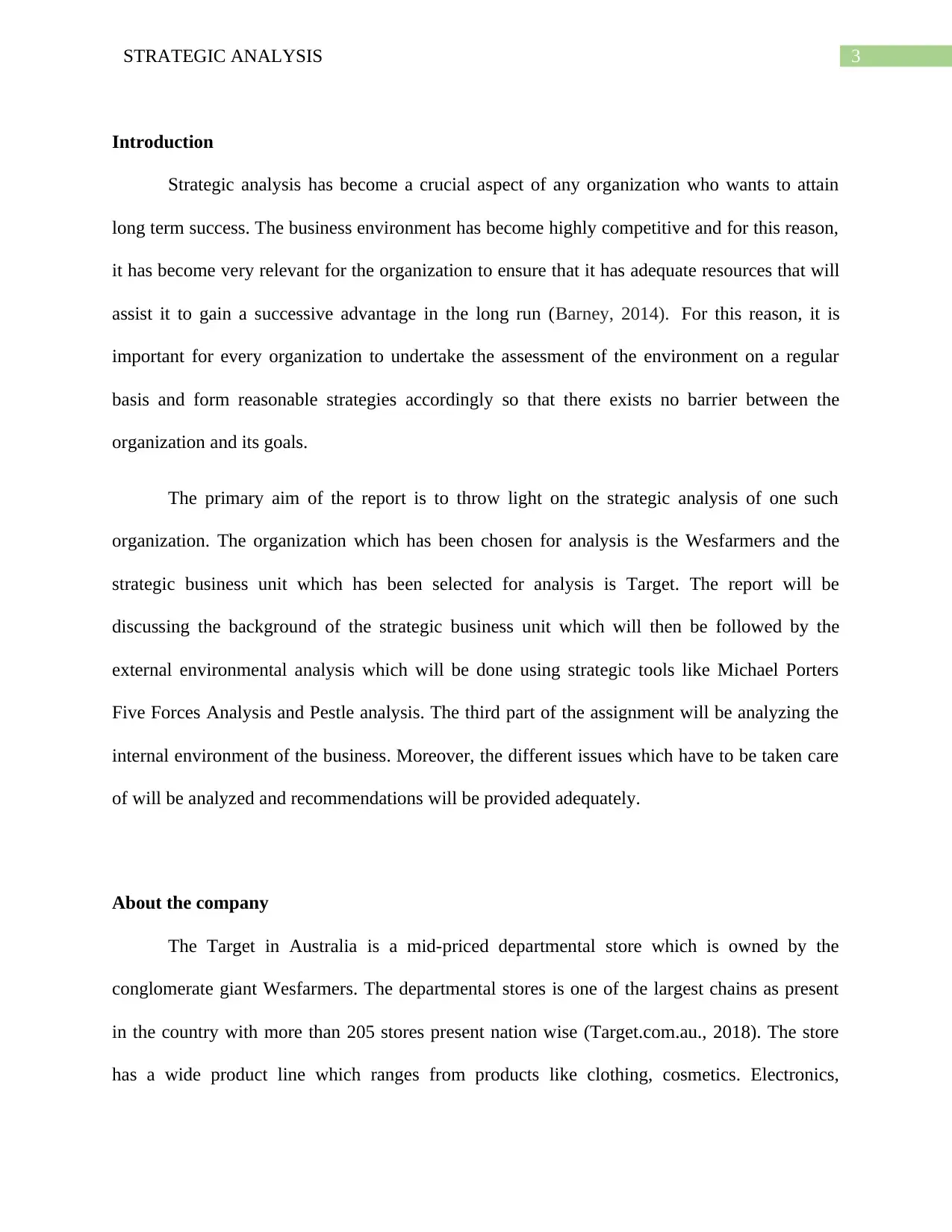
3STRATEGIC ANALYSIS
Introduction
Strategic analysis has become a crucial aspect of any organization who wants to attain
long term success. The business environment has become highly competitive and for this reason,
it has become very relevant for the organization to ensure that it has adequate resources that will
assist it to gain a successive advantage in the long run (Barney, 2014). For this reason, it is
important for every organization to undertake the assessment of the environment on a regular
basis and form reasonable strategies accordingly so that there exists no barrier between the
organization and its goals.
The primary aim of the report is to throw light on the strategic analysis of one such
organization. The organization which has been chosen for analysis is the Wesfarmers and the
strategic business unit which has been selected for analysis is Target. The report will be
discussing the background of the strategic business unit which will then be followed by the
external environmental analysis which will be done using strategic tools like Michael Porters
Five Forces Analysis and Pestle analysis. The third part of the assignment will be analyzing the
internal environment of the business. Moreover, the different issues which have to be taken care
of will be analyzed and recommendations will be provided adequately.
About the company
The Target in Australia is a mid-priced departmental store which is owned by the
conglomerate giant Wesfarmers. The departmental stores is one of the largest chains as present
in the country with more than 205 stores present nation wise (Target.com.au., 2018). The store
has a wide product line which ranges from products like clothing, cosmetics. Electronics,
Introduction
Strategic analysis has become a crucial aspect of any organization who wants to attain
long term success. The business environment has become highly competitive and for this reason,
it has become very relevant for the organization to ensure that it has adequate resources that will
assist it to gain a successive advantage in the long run (Barney, 2014). For this reason, it is
important for every organization to undertake the assessment of the environment on a regular
basis and form reasonable strategies accordingly so that there exists no barrier between the
organization and its goals.
The primary aim of the report is to throw light on the strategic analysis of one such
organization. The organization which has been chosen for analysis is the Wesfarmers and the
strategic business unit which has been selected for analysis is Target. The report will be
discussing the background of the strategic business unit which will then be followed by the
external environmental analysis which will be done using strategic tools like Michael Porters
Five Forces Analysis and Pestle analysis. The third part of the assignment will be analyzing the
internal environment of the business. Moreover, the different issues which have to be taken care
of will be analyzed and recommendations will be provided adequately.
About the company
The Target in Australia is a mid-priced departmental store which is owned by the
conglomerate giant Wesfarmers. The departmental stores is one of the largest chains as present
in the country with more than 205 stores present nation wise (Target.com.au., 2018). The store
has a wide product line which ranges from products like clothing, cosmetics. Electronics,
Paraphrase This Document
Need a fresh take? Get an instant paraphrase of this document with our AI Paraphraser
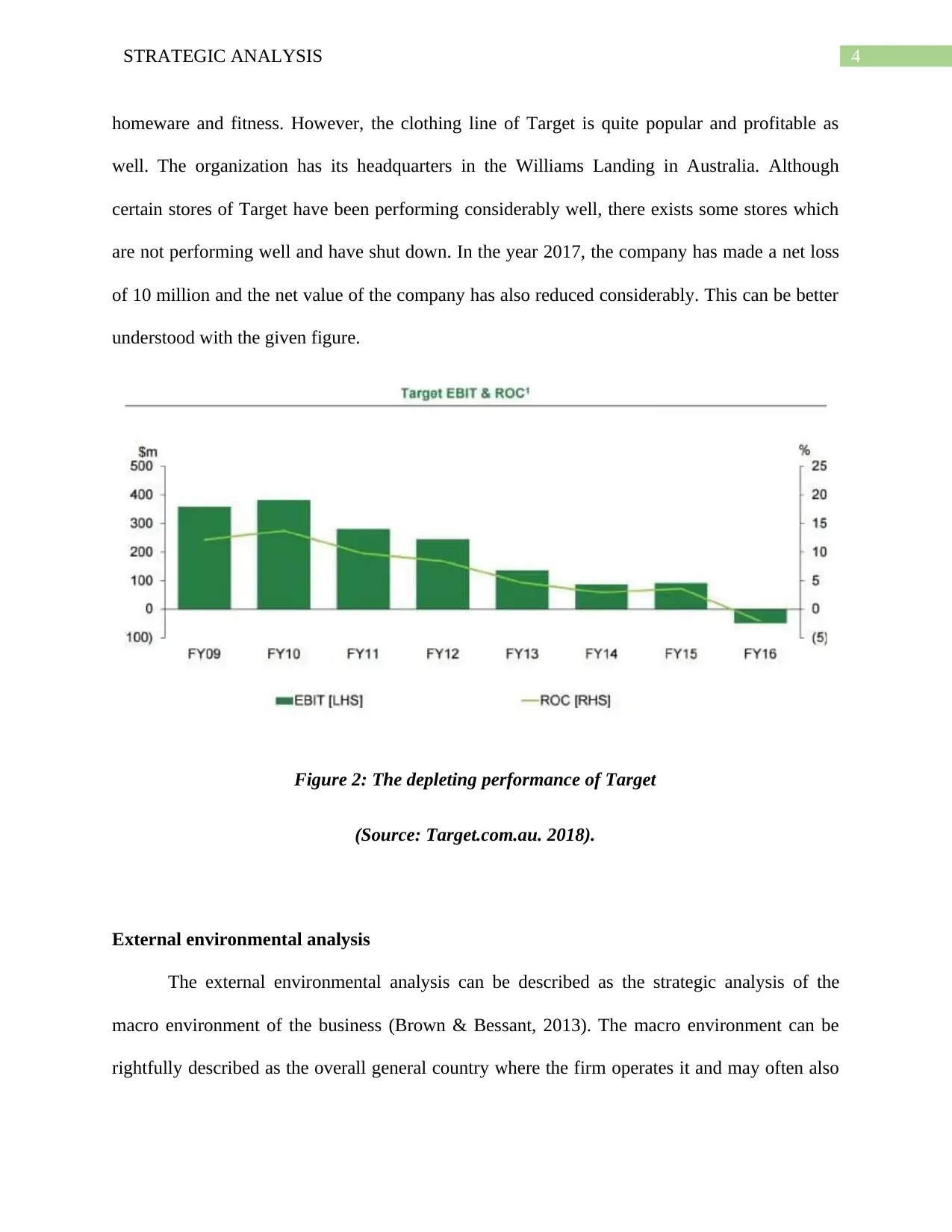
4STRATEGIC ANALYSIS
homeware and fitness. However, the clothing line of Target is quite popular and profitable as
well. The organization has its headquarters in the Williams Landing in Australia. Although
certain stores of Target have been performing considerably well, there exists some stores which
are not performing well and have shut down. In the year 2017, the company has made a net loss
of 10 million and the net value of the company has also reduced considerably. This can be better
understood with the given figure.
Figure 2: The depleting performance of Target
(Source: Target.com.au. 2018).
External environmental analysis
The external environmental analysis can be described as the strategic analysis of the
macro environment of the business (Brown & Bessant, 2013). The macro environment can be
rightfully described as the overall general country where the firm operates it and may often also
homeware and fitness. However, the clothing line of Target is quite popular and profitable as
well. The organization has its headquarters in the Williams Landing in Australia. Although
certain stores of Target have been performing considerably well, there exists some stores which
are not performing well and have shut down. In the year 2017, the company has made a net loss
of 10 million and the net value of the company has also reduced considerably. This can be better
understood with the given figure.
Figure 2: The depleting performance of Target
(Source: Target.com.au. 2018).
External environmental analysis
The external environmental analysis can be described as the strategic analysis of the
macro environment of the business (Brown & Bessant, 2013). The macro environment can be
rightfully described as the overall general country where the firm operates it and may often also
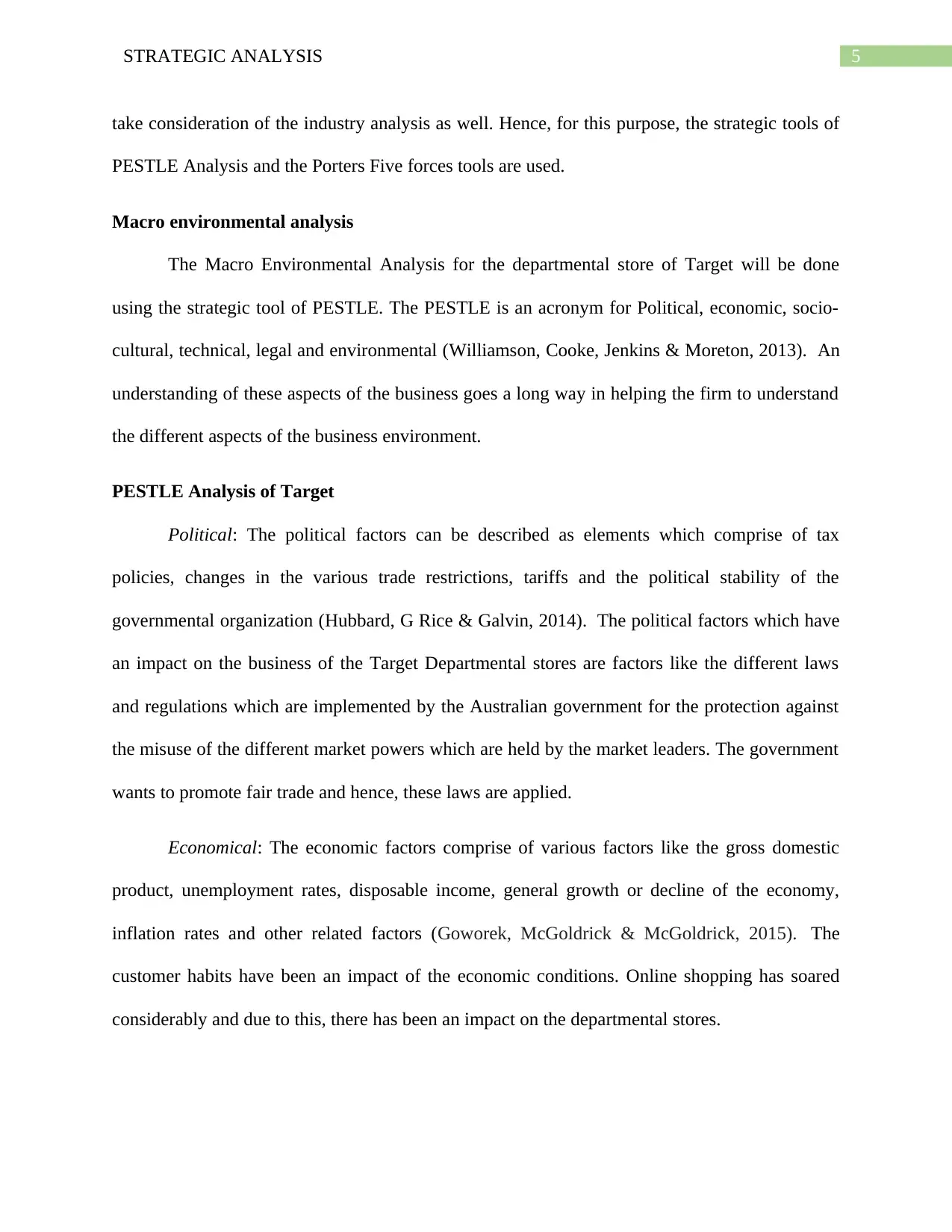
5STRATEGIC ANALYSIS
take consideration of the industry analysis as well. Hence, for this purpose, the strategic tools of
PESTLE Analysis and the Porters Five forces tools are used.
Macro environmental analysis
The Macro Environmental Analysis for the departmental store of Target will be done
using the strategic tool of PESTLE. The PESTLE is an acronym for Political, economic, socio-
cultural, technical, legal and environmental (Williamson, Cooke, Jenkins & Moreton, 2013). An
understanding of these aspects of the business goes a long way in helping the firm to understand
the different aspects of the business environment.
PESTLE Analysis of Target
Political: The political factors can be described as elements which comprise of tax
policies, changes in the various trade restrictions, tariffs and the political stability of the
governmental organization (Hubbard, G Rice & Galvin, 2014). The political factors which have
an impact on the business of the Target Departmental stores are factors like the different laws
and regulations which are implemented by the Australian government for the protection against
the misuse of the different market powers which are held by the market leaders. The government
wants to promote fair trade and hence, these laws are applied.
Economical: The economic factors comprise of various factors like the gross domestic
product, unemployment rates, disposable income, general growth or decline of the economy,
inflation rates and other related factors (Goworek, McGoldrick & McGoldrick, 2015). The
customer habits have been an impact of the economic conditions. Online shopping has soared
considerably and due to this, there has been an impact on the departmental stores.
take consideration of the industry analysis as well. Hence, for this purpose, the strategic tools of
PESTLE Analysis and the Porters Five forces tools are used.
Macro environmental analysis
The Macro Environmental Analysis for the departmental store of Target will be done
using the strategic tool of PESTLE. The PESTLE is an acronym for Political, economic, socio-
cultural, technical, legal and environmental (Williamson, Cooke, Jenkins & Moreton, 2013). An
understanding of these aspects of the business goes a long way in helping the firm to understand
the different aspects of the business environment.
PESTLE Analysis of Target
Political: The political factors can be described as elements which comprise of tax
policies, changes in the various trade restrictions, tariffs and the political stability of the
governmental organization (Hubbard, G Rice & Galvin, 2014). The political factors which have
an impact on the business of the Target Departmental stores are factors like the different laws
and regulations which are implemented by the Australian government for the protection against
the misuse of the different market powers which are held by the market leaders. The government
wants to promote fair trade and hence, these laws are applied.
Economical: The economic factors comprise of various factors like the gross domestic
product, unemployment rates, disposable income, general growth or decline of the economy,
inflation rates and other related factors (Goworek, McGoldrick & McGoldrick, 2015). The
customer habits have been an impact of the economic conditions. Online shopping has soared
considerably and due to this, there has been an impact on the departmental stores.
⊘ This is a preview!⊘
Do you want full access?
Subscribe today to unlock all pages.

Trusted by 1+ million students worldwide
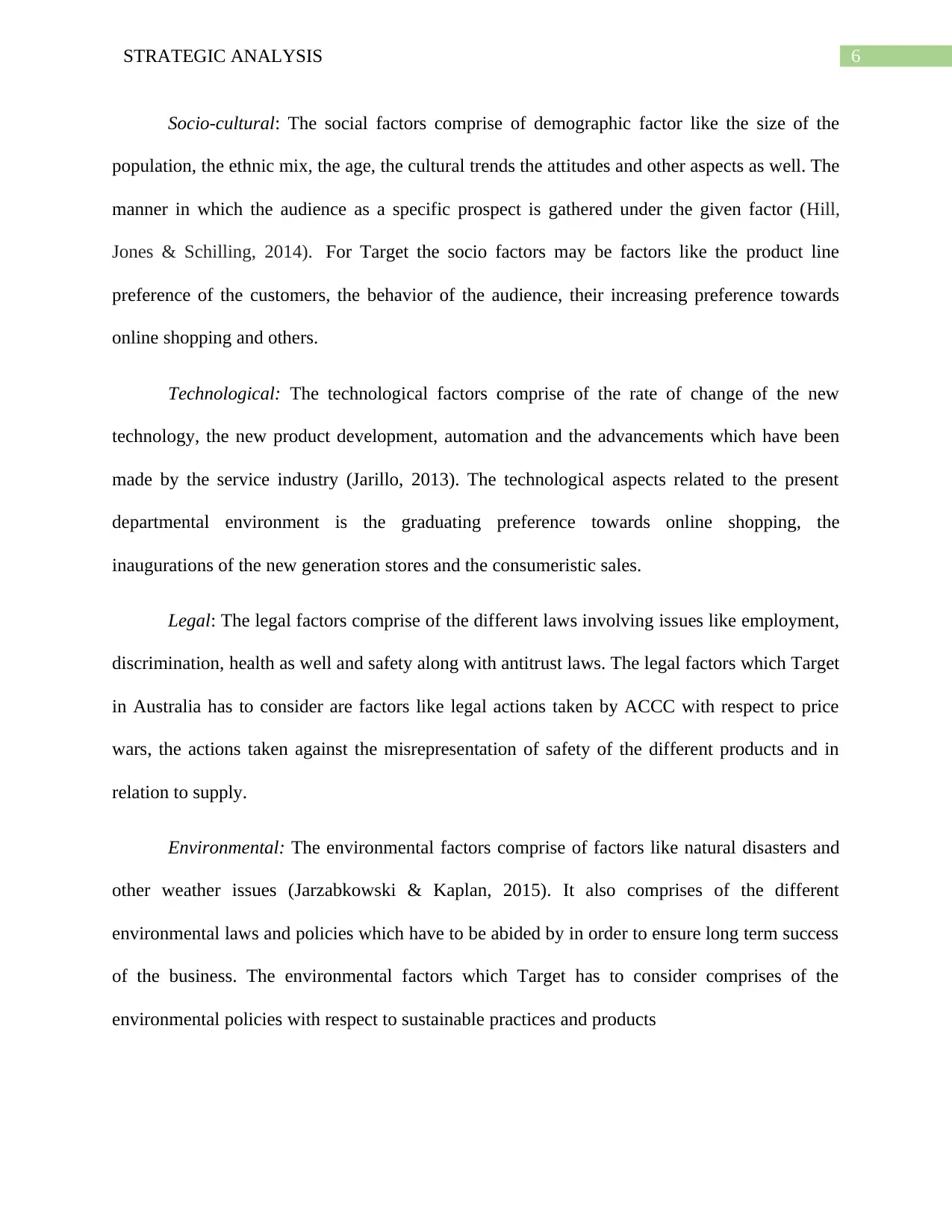
6STRATEGIC ANALYSIS
Socio-cultural: The social factors comprise of demographic factor like the size of the
population, the ethnic mix, the age, the cultural trends the attitudes and other aspects as well. The
manner in which the audience as a specific prospect is gathered under the given factor (Hill,
Jones & Schilling, 2014). For Target the socio factors may be factors like the product line
preference of the customers, the behavior of the audience, their increasing preference towards
online shopping and others.
Technological: The technological factors comprise of the rate of change of the new
technology, the new product development, automation and the advancements which have been
made by the service industry (Jarillo, 2013). The technological aspects related to the present
departmental environment is the graduating preference towards online shopping, the
inaugurations of the new generation stores and the consumeristic sales.
Legal: The legal factors comprise of the different laws involving issues like employment,
discrimination, health as well and safety along with antitrust laws. The legal factors which Target
in Australia has to consider are factors like legal actions taken by ACCC with respect to price
wars, the actions taken against the misrepresentation of safety of the different products and in
relation to supply.
Environmental: The environmental factors comprise of factors like natural disasters and
other weather issues (Jarzabkowski & Kaplan, 2015). It also comprises of the different
environmental laws and policies which have to be abided by in order to ensure long term success
of the business. The environmental factors which Target has to consider comprises of the
environmental policies with respect to sustainable practices and products
Socio-cultural: The social factors comprise of demographic factor like the size of the
population, the ethnic mix, the age, the cultural trends the attitudes and other aspects as well. The
manner in which the audience as a specific prospect is gathered under the given factor (Hill,
Jones & Schilling, 2014). For Target the socio factors may be factors like the product line
preference of the customers, the behavior of the audience, their increasing preference towards
online shopping and others.
Technological: The technological factors comprise of the rate of change of the new
technology, the new product development, automation and the advancements which have been
made by the service industry (Jarillo, 2013). The technological aspects related to the present
departmental environment is the graduating preference towards online shopping, the
inaugurations of the new generation stores and the consumeristic sales.
Legal: The legal factors comprise of the different laws involving issues like employment,
discrimination, health as well and safety along with antitrust laws. The legal factors which Target
in Australia has to consider are factors like legal actions taken by ACCC with respect to price
wars, the actions taken against the misrepresentation of safety of the different products and in
relation to supply.
Environmental: The environmental factors comprise of factors like natural disasters and
other weather issues (Jarzabkowski & Kaplan, 2015). It also comprises of the different
environmental laws and policies which have to be abided by in order to ensure long term success
of the business. The environmental factors which Target has to consider comprises of the
environmental policies with respect to sustainable practices and products
Paraphrase This Document
Need a fresh take? Get an instant paraphrase of this document with our AI Paraphraser
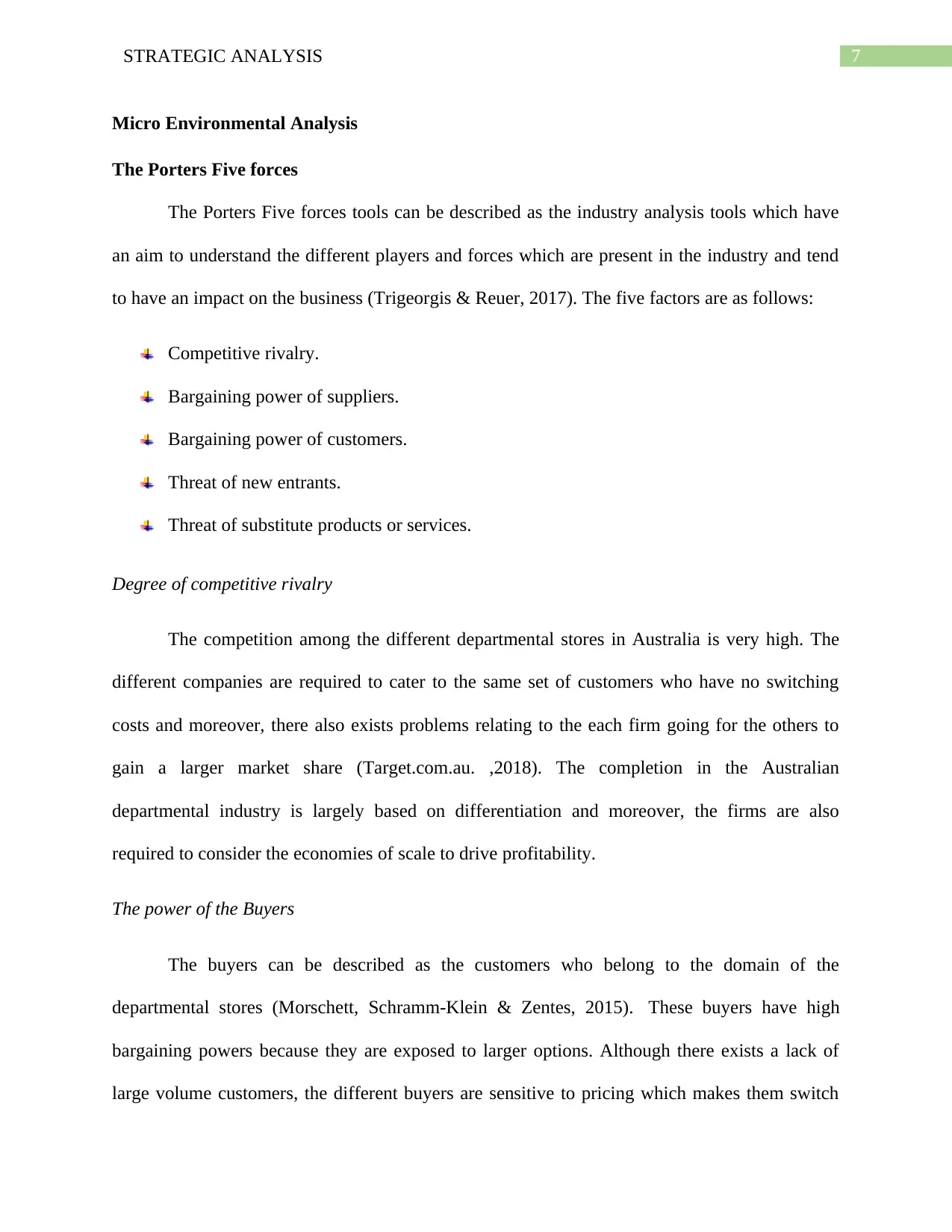
7STRATEGIC ANALYSIS
Micro Environmental Analysis
The Porters Five forces
The Porters Five forces tools can be described as the industry analysis tools which have
an aim to understand the different players and forces which are present in the industry and tend
to have an impact on the business (Trigeorgis & Reuer, 2017). The five factors are as follows:
Competitive rivalry.
Bargaining power of suppliers.
Bargaining power of customers.
Threat of new entrants.
Threat of substitute products or services.
Degree of competitive rivalry
The competition among the different departmental stores in Australia is very high. The
different companies are required to cater to the same set of customers who have no switching
costs and moreover, there also exists problems relating to the each firm going for the others to
gain a larger market share (Target.com.au. ,2018). The completion in the Australian
departmental industry is largely based on differentiation and moreover, the firms are also
required to consider the economies of scale to drive profitability.
The power of the Buyers
The buyers can be described as the customers who belong to the domain of the
departmental stores (Morschett, Schramm-Klein & Zentes, 2015). These buyers have high
bargaining powers because they are exposed to larger options. Although there exists a lack of
large volume customers, the different buyers are sensitive to pricing which makes them switch
Micro Environmental Analysis
The Porters Five forces
The Porters Five forces tools can be described as the industry analysis tools which have
an aim to understand the different players and forces which are present in the industry and tend
to have an impact on the business (Trigeorgis & Reuer, 2017). The five factors are as follows:
Competitive rivalry.
Bargaining power of suppliers.
Bargaining power of customers.
Threat of new entrants.
Threat of substitute products or services.
Degree of competitive rivalry
The competition among the different departmental stores in Australia is very high. The
different companies are required to cater to the same set of customers who have no switching
costs and moreover, there also exists problems relating to the each firm going for the others to
gain a larger market share (Target.com.au. ,2018). The completion in the Australian
departmental industry is largely based on differentiation and moreover, the firms are also
required to consider the economies of scale to drive profitability.
The power of the Buyers
The buyers can be described as the customers who belong to the domain of the
departmental stores (Morschett, Schramm-Klein & Zentes, 2015). These buyers have high
bargaining powers because they are exposed to larger options. Although there exists a lack of
large volume customers, the different buyers are sensitive to pricing which makes them switch
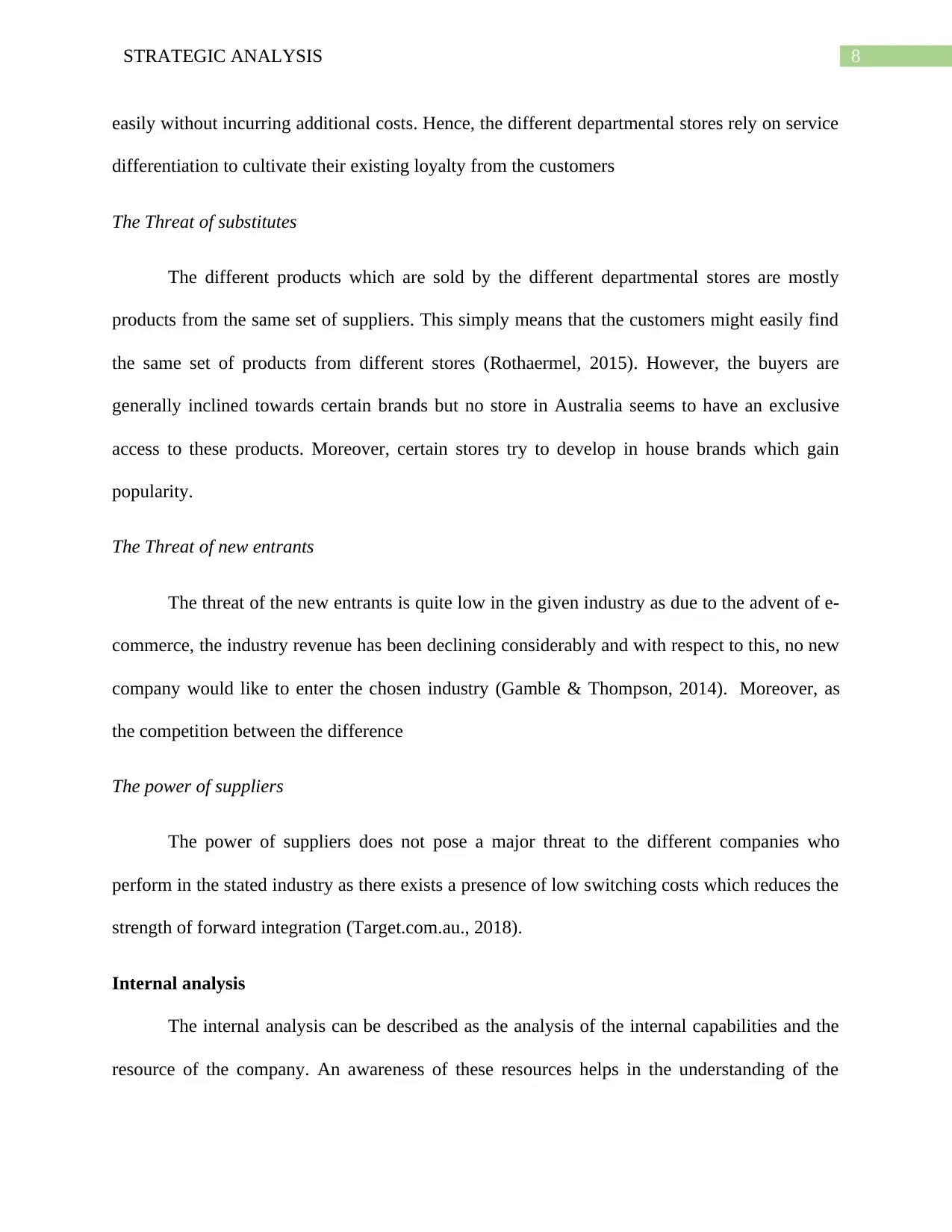
8STRATEGIC ANALYSIS
easily without incurring additional costs. Hence, the different departmental stores rely on service
differentiation to cultivate their existing loyalty from the customers
The Threat of substitutes
The different products which are sold by the different departmental stores are mostly
products from the same set of suppliers. This simply means that the customers might easily find
the same set of products from different stores (Rothaermel, 2015). However, the buyers are
generally inclined towards certain brands but no store in Australia seems to have an exclusive
access to these products. Moreover, certain stores try to develop in house brands which gain
popularity.
The Threat of new entrants
The threat of the new entrants is quite low in the given industry as due to the advent of e-
commerce, the industry revenue has been declining considerably and with respect to this, no new
company would like to enter the chosen industry (Gamble & Thompson, 2014). Moreover, as
the competition between the difference
The power of suppliers
The power of suppliers does not pose a major threat to the different companies who
perform in the stated industry as there exists a presence of low switching costs which reduces the
strength of forward integration (Target.com.au., 2018).
Internal analysis
The internal analysis can be described as the analysis of the internal capabilities and the
resource of the company. An awareness of these resources helps in the understanding of the
easily without incurring additional costs. Hence, the different departmental stores rely on service
differentiation to cultivate their existing loyalty from the customers
The Threat of substitutes
The different products which are sold by the different departmental stores are mostly
products from the same set of suppliers. This simply means that the customers might easily find
the same set of products from different stores (Rothaermel, 2015). However, the buyers are
generally inclined towards certain brands but no store in Australia seems to have an exclusive
access to these products. Moreover, certain stores try to develop in house brands which gain
popularity.
The Threat of new entrants
The threat of the new entrants is quite low in the given industry as due to the advent of e-
commerce, the industry revenue has been declining considerably and with respect to this, no new
company would like to enter the chosen industry (Gamble & Thompson, 2014). Moreover, as
the competition between the difference
The power of suppliers
The power of suppliers does not pose a major threat to the different companies who
perform in the stated industry as there exists a presence of low switching costs which reduces the
strength of forward integration (Target.com.au., 2018).
Internal analysis
The internal analysis can be described as the analysis of the internal capabilities and the
resource of the company. An awareness of these resources helps in the understanding of the
⊘ This is a preview!⊘
Do you want full access?
Subscribe today to unlock all pages.

Trusted by 1+ million students worldwide
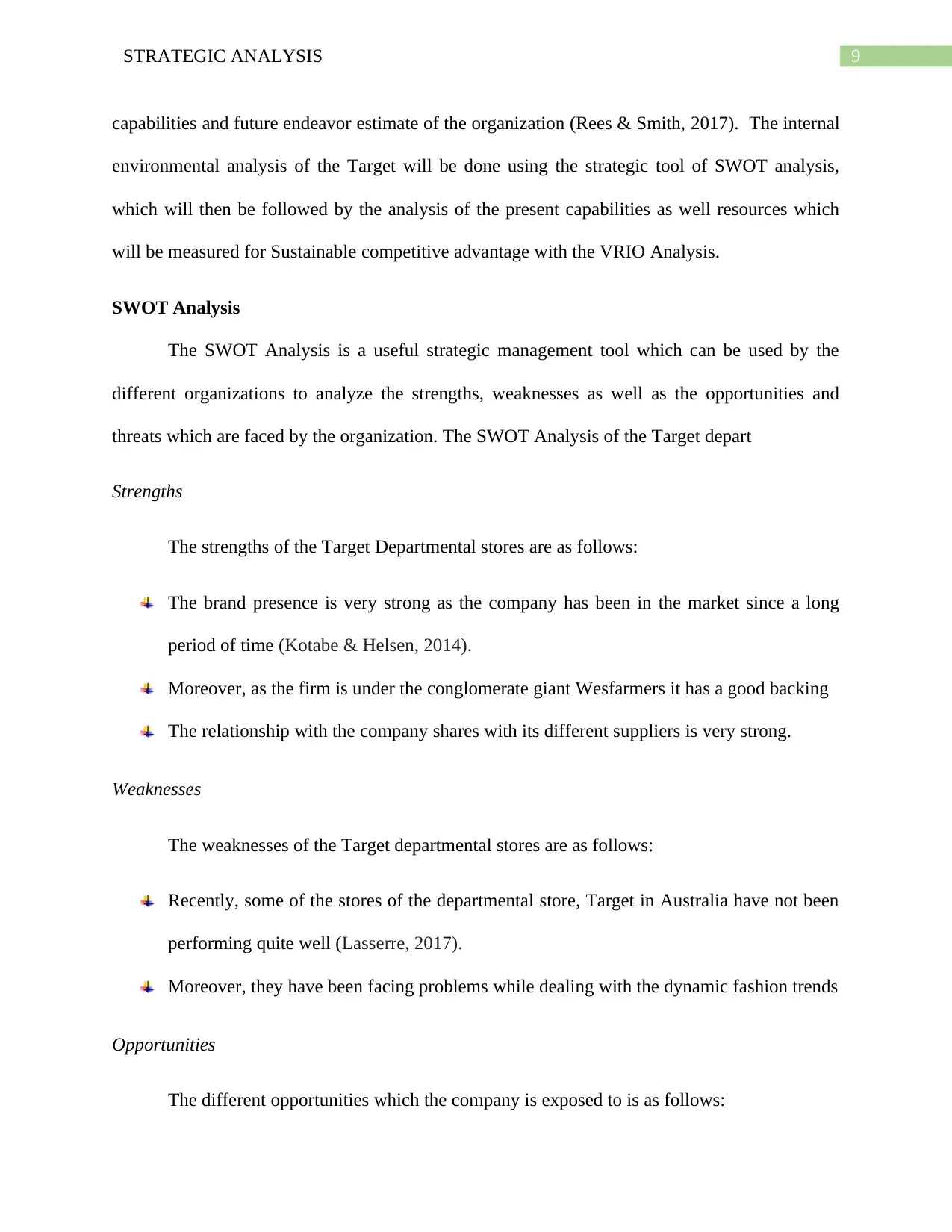
9STRATEGIC ANALYSIS
capabilities and future endeavor estimate of the organization (Rees & Smith, 2017). The internal
environmental analysis of the Target will be done using the strategic tool of SWOT analysis,
which will then be followed by the analysis of the present capabilities as well resources which
will be measured for Sustainable competitive advantage with the VRIO Analysis.
SWOT Analysis
The SWOT Analysis is a useful strategic management tool which can be used by the
different organizations to analyze the strengths, weaknesses as well as the opportunities and
threats which are faced by the organization. The SWOT Analysis of the Target depart
Strengths
The strengths of the Target Departmental stores are as follows:
The brand presence is very strong as the company has been in the market since a long
period of time (Kotabe & Helsen, 2014).
Moreover, as the firm is under the conglomerate giant Wesfarmers it has a good backing
The relationship with the company shares with its different suppliers is very strong.
Weaknesses
The weaknesses of the Target departmental stores are as follows:
Recently, some of the stores of the departmental store, Target in Australia have not been
performing quite well (Lasserre, 2017).
Moreover, they have been facing problems while dealing with the dynamic fashion trends
Opportunities
The different opportunities which the company is exposed to is as follows:
capabilities and future endeavor estimate of the organization (Rees & Smith, 2017). The internal
environmental analysis of the Target will be done using the strategic tool of SWOT analysis,
which will then be followed by the analysis of the present capabilities as well resources which
will be measured for Sustainable competitive advantage with the VRIO Analysis.
SWOT Analysis
The SWOT Analysis is a useful strategic management tool which can be used by the
different organizations to analyze the strengths, weaknesses as well as the opportunities and
threats which are faced by the organization. The SWOT Analysis of the Target depart
Strengths
The strengths of the Target Departmental stores are as follows:
The brand presence is very strong as the company has been in the market since a long
period of time (Kotabe & Helsen, 2014).
Moreover, as the firm is under the conglomerate giant Wesfarmers it has a good backing
The relationship with the company shares with its different suppliers is very strong.
Weaknesses
The weaknesses of the Target departmental stores are as follows:
Recently, some of the stores of the departmental store, Target in Australia have not been
performing quite well (Lasserre, 2017).
Moreover, they have been facing problems while dealing with the dynamic fashion trends
Opportunities
The different opportunities which the company is exposed to is as follows:
Paraphrase This Document
Need a fresh take? Get an instant paraphrase of this document with our AI Paraphraser
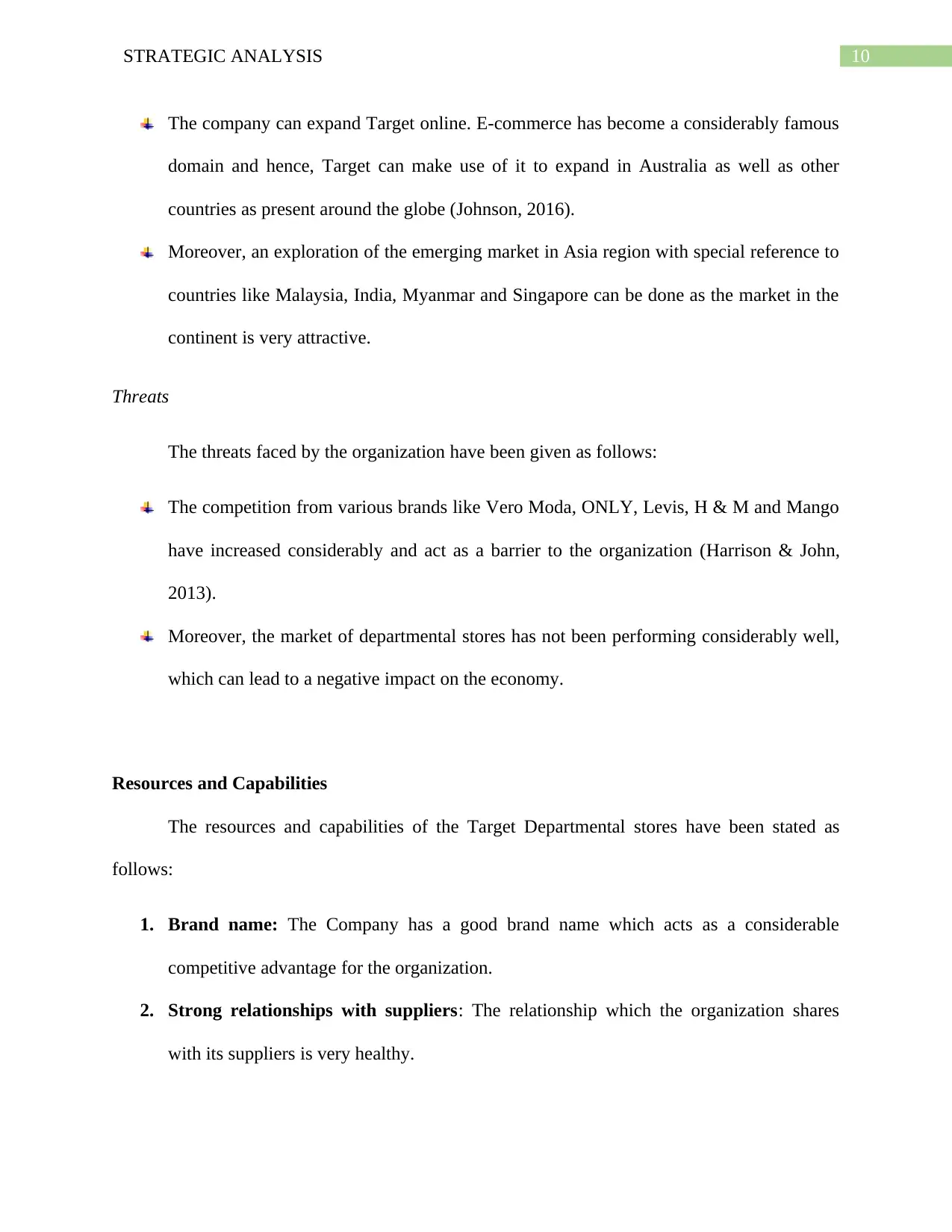
10STRATEGIC ANALYSIS
The company can expand Target online. E-commerce has become a considerably famous
domain and hence, Target can make use of it to expand in Australia as well as other
countries as present around the globe (Johnson, 2016).
Moreover, an exploration of the emerging market in Asia region with special reference to
countries like Malaysia, India, Myanmar and Singapore can be done as the market in the
continent is very attractive.
Threats
The threats faced by the organization have been given as follows:
The competition from various brands like Vero Moda, ONLY, Levis, H & M and Mango
have increased considerably and act as a barrier to the organization (Harrison & John,
2013).
Moreover, the market of departmental stores has not been performing considerably well,
which can lead to a negative impact on the economy.
Resources and Capabilities
The resources and capabilities of the Target Departmental stores have been stated as
follows:
1. Brand name: The Company has a good brand name which acts as a considerable
competitive advantage for the organization.
2. Strong relationships with suppliers: The relationship which the organization shares
with its suppliers is very healthy.
The company can expand Target online. E-commerce has become a considerably famous
domain and hence, Target can make use of it to expand in Australia as well as other
countries as present around the globe (Johnson, 2016).
Moreover, an exploration of the emerging market in Asia region with special reference to
countries like Malaysia, India, Myanmar and Singapore can be done as the market in the
continent is very attractive.
Threats
The threats faced by the organization have been given as follows:
The competition from various brands like Vero Moda, ONLY, Levis, H & M and Mango
have increased considerably and act as a barrier to the organization (Harrison & John,
2013).
Moreover, the market of departmental stores has not been performing considerably well,
which can lead to a negative impact on the economy.
Resources and Capabilities
The resources and capabilities of the Target Departmental stores have been stated as
follows:
1. Brand name: The Company has a good brand name which acts as a considerable
competitive advantage for the organization.
2. Strong relationships with suppliers: The relationship which the organization shares
with its suppliers is very healthy.
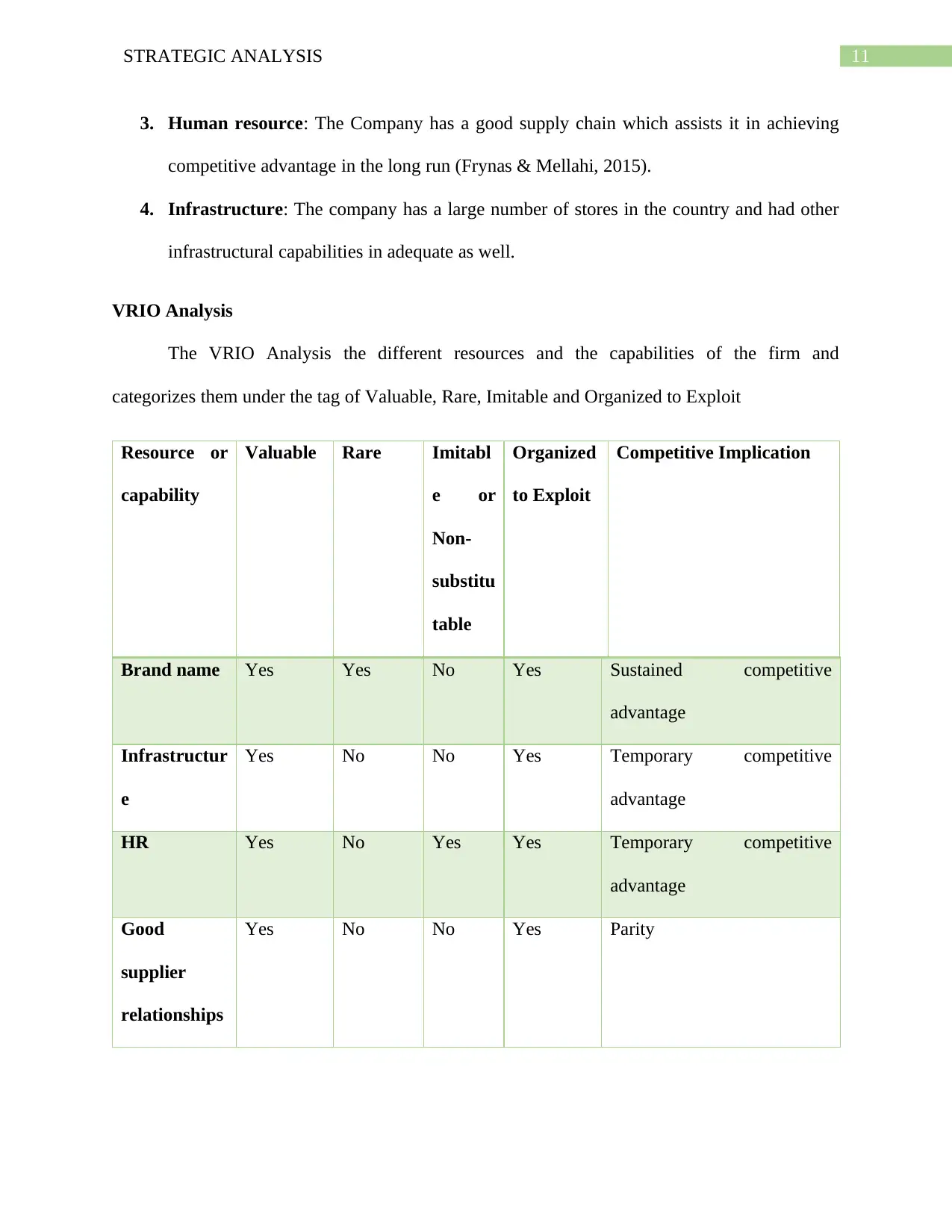
11STRATEGIC ANALYSIS
3. Human resource: The Company has a good supply chain which assists it in achieving
competitive advantage in the long run (Frynas & Mellahi, 2015).
4. Infrastructure: The company has a large number of stores in the country and had other
infrastructural capabilities in adequate as well.
VRIO Analysis
The VRIO Analysis the different resources and the capabilities of the firm and
categorizes them under the tag of Valuable, Rare, Imitable and Organized to Exploit
Resource or
capability
Valuable Rare Imitabl
e or
Non-
substitu
table
Organized
to Exploit
Competitive Implication
Brand name Yes Yes No Yes Sustained competitive
advantage
Infrastructur
e
Yes No No Yes Temporary competitive
advantage
HR Yes No Yes Yes Temporary competitive
advantage
Good
supplier
relationships
Yes No No Yes Parity
3. Human resource: The Company has a good supply chain which assists it in achieving
competitive advantage in the long run (Frynas & Mellahi, 2015).
4. Infrastructure: The company has a large number of stores in the country and had other
infrastructural capabilities in adequate as well.
VRIO Analysis
The VRIO Analysis the different resources and the capabilities of the firm and
categorizes them under the tag of Valuable, Rare, Imitable and Organized to Exploit
Resource or
capability
Valuable Rare Imitabl
e or
Non-
substitu
table
Organized
to Exploit
Competitive Implication
Brand name Yes Yes No Yes Sustained competitive
advantage
Infrastructur
e
Yes No No Yes Temporary competitive
advantage
HR Yes No Yes Yes Temporary competitive
advantage
Good
supplier
relationships
Yes No No Yes Parity
⊘ This is a preview!⊘
Do you want full access?
Subscribe today to unlock all pages.

Trusted by 1+ million students worldwide
1 out of 16
Related Documents
Your All-in-One AI-Powered Toolkit for Academic Success.
+13062052269
info@desklib.com
Available 24*7 on WhatsApp / Email
![[object Object]](/_next/static/media/star-bottom.7253800d.svg)
Unlock your academic potential
Copyright © 2020–2025 A2Z Services. All Rights Reserved. Developed and managed by ZUCOL.



